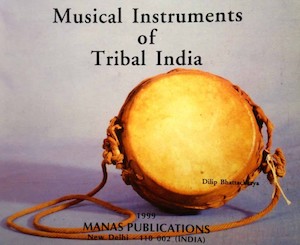Banam Raja from adivaani on Vimeo.
At the end of the day, Santals return to music to become whole again. They bring out their instruments into the courtyard and music, lyrics and song turn into stars in the night sky. Our musical traditions are millennial.
The banam is a stringed instrument. Banams are the lutes and the fiddles of the Santal people. They are made from locally available material–wood, vegetables and animal hide. The most common banams still made and played by Santals are the Dhodro Banam, the Reta Banam and the Phentor Banam.
This video is a tribute to our artists, who have kept our culture alive through generations.
For more: adivaani.org
Film credits: Joy Raj Eric Tudu (direction and camera), Luis A. Gomez (sound recording), Saheb Ram Tudu (editing and art work), Ruby Hembrom (executive producer)

Musical Instruments of Tribal India
by Dilip Bhattacharya >>
See also
Audio | Santali Traditional and Fusion Songs: Ghosaldanga Bishnubati Adibasi Trust – West Bengal
Crafts and visual arts | Masks
India’s tribal, folk and devotional music: Secular and ceremonial songs
Memory of the World Programme – Unesco
Music and dance | Musicology | Adivasi music and the public stage by Jayasri Banerjee
Video | Banam lutes and fiddles of the Santal people – Jharkhand & West Bengal
Video | Celestial Dancers of Manipur
Video | Cultural traditions of the Halakki people – Karnataka
Video | Khasi musical heritage of Meghalaya
Video | Kota women’s dance: Shivaratri celebrations – Nilgiris – Tamil Nadu
Video | Santali video album “Ale Ato” (Our Village, Part 1 of 2) – West Bengal
Video | South Gujarat tribal music documentation by Bhasha – Gujarat
Video | Tribes in Transition-III: “Indigenous Cultures in the Digital Era”
Video | Safe contents for educational use on many topics (music, visual arts and more)
Research the above issues with the help of Shodhganga: A reservoir of theses from universities all over India, made available under Open Access >>